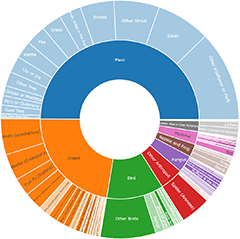Skinks
Skinks (Scincidae) are one of five groups of lizards found in the area - the others are dragons, legless-lizards, geckos and monitors.
Generally skinks have smooth scales (in some species scales may be somewhat iridescent), often lack necks, and legs may be relatively small, reduced or lacking. Several genera have fewer than five toes (digits) on each foot. As a general rule, the longer the digits, the more arboreal the species is likely to be. In species with reduced limbs, their locomotion resembles that of snakes.
Most species of skinks have long, tapering tails, which can be shed if predators grab onto them and which can generally be regenerated, though imperfectly. Species with stumpy tails have no special regenerative abilities.
Skinks are generally carnivorous and in particular insectivorous. Typical prey includes flies, crickets, grasshoppers, beetles and caterpillar and for some species may include earthworms, millipedes, snails, slugs, isopods. other lizards, and small rodents. Skinks use their tongues to sniff the air and track their prey. They can chase down prey until they corner it or manage to land a bite and then swallow it whole.
Most spend their time underground where they are mostly safe from predators, and a common characteristic is digging and burrowing. Often they dig out tunnels for easy navigation.
Currently there are about 1500 species of skink worldwide, and in Australia about 33 genera and 320 species. However taxonomic research is constantly revising the classification of species.
There is some agreement that skinks consist of three broad branches (clads): Egernia Group (including local genera Cyclodomorphus, Egernia, Liopholis and Tiliqua), Eugongylus Group (including Acritoscincus, Carlia, Menetia, Morethia, Niveoscincus, Nannoscincus, Pseudemoia and Saproscincus), and Sphenomorphus Group (Ctenotus, Eulamprus and Hemiergis).
Announcements
There are currently no announcements.
Discussion
Tiliqua rugosa aspera
Tiliqua scincoides scincoides
Bellatorias frerei
Significant sightings
- Tiliqua nigrolutea at O'Malley, ACT
- Egernia striolata at Frogmore, NSW
- Eulamprus heatwolei at Katoomba, NSW
- Acritoscincus duperreyi at Tharwa, ACT
- Carinascincus coventryi at Thredbo, NSW
- Ctenotus orientalis at Tralee, NSW
- Carlia tetradactyla at Kambah, ACT
- Liopholis whitii at Tharwa, ACT
- Liopholis whitii at Mount Clear, ACT
Top contributors
- Christine 192
- SWishart 183
- JohnBundock 167
- KShort 153
- MatthewFrawley 103
- trevorpreston 100
- KMcCue 95
- AlisonMilton 76
- AaronClausen 76
- RodDeb 72
Top moderators
- wombey 1.8K
- WillO 770
- GeoffRobertson 669
- PatrickCampbell2 283
- PatrickCampbell 170
- BrianLR 115
- MichaelMulvaney 82
- DamianMichael 49
- waltraud 27
- MichaelBedingfield 24








































































